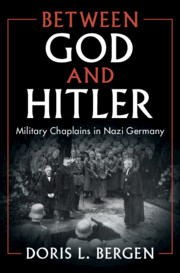Book contents
- Between God and Hitler
- Between God and Hitler
- Copyright page
- Contents
- Figures
- Table
- Preface
- Acknowledgments
- Note on the Text
- Abbreviations
- Introduction
- 1 “We Will Not Let Our Swords Get Rusty”
- 2 “In Times of Peace the Church Arms Herself for War”
- 3 “Gott mit uns”
- 4 Saving Christianity, Killing Jews
- 5 “The Power of Christian Truth and Christian Faith”
- 6 “What Should We Preach Now?”
- 7 From Nazi Past to Christian Future
- Conclusion
- Notes
- Bibliography
- Index
Introduction
An Incongruous Institution
Published online by Cambridge University Press: 14 April 2023
- Between God and Hitler
- Between God and Hitler
- Copyright page
- Contents
- Figures
- Table
- Preface
- Acknowledgments
- Note on the Text
- Abbreviations
- Introduction
- 1 “We Will Not Let Our Swords Get Rusty”
- 2 “In Times of Peace the Church Arms Herself for War”
- 3 “Gott mit uns”
- 4 Saving Christianity, Killing Jews
- 5 “The Power of Christian Truth and Christian Faith”
- 6 “What Should We Preach Now?”
- 7 From Nazi Past to Christian Future
- Conclusion
- Notes
- Bibliography
- Index
Summary
The Introduction opens by establishing a central point of the book: that German military chaplains were physically present at sites of mass killing of Jews and other victims of the Holocaust and World War II. The 1941 massacre of Jewish children at Bila Tserkva in occupied Ukraine is described and analyzed using German and Jewish sources. The theme of power and legitimation, which runs throughout the entire book, is presented. Building from the killing at Bila Tserkva and the role of chaplains there, the chapter shows how the Wehrmacht chaplains had considerable power. They served to legitimize Hitler’s regime and its genocidal war and played a key role in creating a reassuring narrative of events for German soldiers, their families, and the chaplains themselves. Other themes introduced include systems and dynamics (the importance of the chaplaincy as an institution), the forces of war and the confusion it generates, and habit: chaplains’ actions and decisions even before the war set patterns that became entrenched. The sources and methodology are explained, with emphasis on integrating Jewish sources.
Keywords
Information
- Type
- Chapter
- Information
- Between God and HitlerMilitary Chaplains in Nazi Germany, pp. 1 - 21Publisher: Cambridge University PressPrint publication year: 2023
